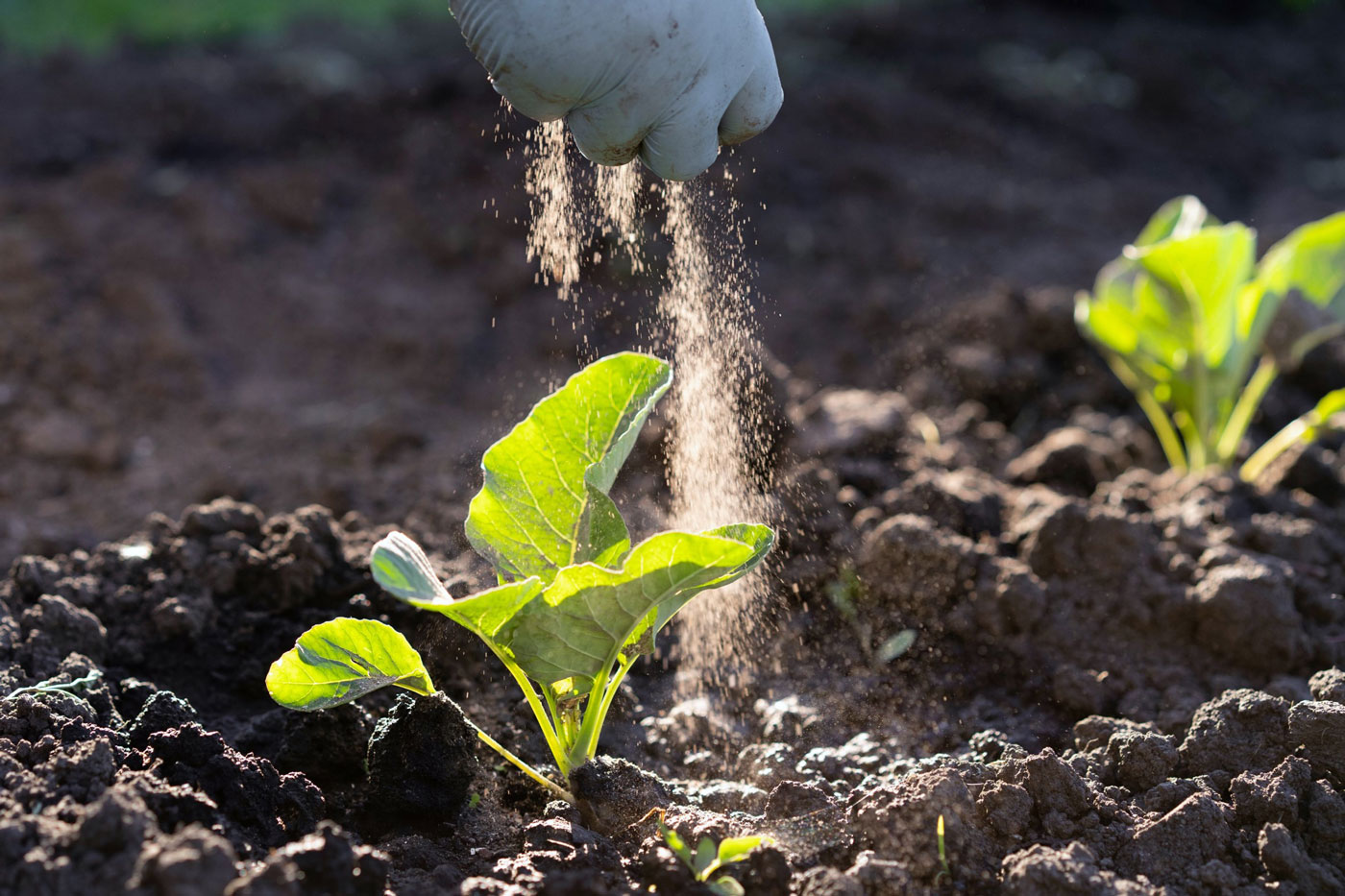
(Credit: Adobestock Images)
To many, the term "side-dressing" might conjure up images of a savory dish that accompanies turkey at Thanksgiving or other festive meals. To gardeners, however, the term refers to the practice of placing fertilizer in a band along-side rows of plants, or around the perimeter of individual plants after they have started to grow in an attempt to boost lagging soil fertility.
Garden plants remove nutrients from the soil as they grow. This especially is true for species considered to be "heavy feeders" such as tomato and sweet corn. Additionally, excessive rainfall tends to reduce soil nutrient levels due to leaching. Fortunately, there are several ways to counter this reduction in soil nutrients and to maintain better plant growth throughout the summer. Side-dressing is one of the solutions to the problem and can give garden plants a needed boost in growth and productivity.
The fertilizer element nitrogen is very critical for good plant growth. In fact, There is more nitrogen in plants than any other element, with the exception of carbon, hydrogen and oxygen. In addition to being taken up by plant in large quantities, nitrogen is the mineral element most quickly leached from the soil. The leaching occurs because a portion of the nitrogen applied as fertilizer is converted by soil microbes to nitrate (N03-) which has a negative charge. Since soil colloids (particles) also contain negative charges, they tend to repel the N03- instead of holding onto it. This high level of mobility leads to nitrate leaching when soil moisture conditions allow for the downward movement of soil water.

Of all of the mineral elements needed for good plant growth, nitrogen is likely the one that will need to be supplemented via side-dressing. (Credit: Adobestock Images)
Side-dressing with a nitrogen fertilizer or a complete fertilizer high in nitrogen usually is beneficial for many garden crops about four to six weeks after planting. Compounds such as ammonium nitrate, urea, ammonium sulfate and calcium nitrate contain high levels of nitrogen and are often used for the purpose of side-dressing. If these fertilizers are not available, a complete fertilizer high in nitrogen can be used. Beware, however, of lawn fertilizers. Most are high in nitrogen but may be "weed and feed" in formulation. The herbicides contained by the latter should not be applied to garden plants.
As mentioned above, side-dressings are normally applied close to the soil surface. The soluble forms of nitrogen found in compounds such as ammonium nitrate or urea move into the root zone easily as a result of rainfall or irrigation. If mulch has been applied, pull it back and apply the side-dressing beneath it along the row. Push the mulch back into its original place after the fertilizer has been applied.
Ammonium nitrate and similar fertilizers are applied at a rate of about one pound per 100 feet of row (or 100 square feet of bed area). Side-dressings should be placed at least six inches away from the main plant stem to avoid burning. A strip along each side of the row is considered ideal. If the planting has not been mulched, incorporate the fertilizer application lightly into the soil with a garden hoe or rake. Garden fertilizers lower in nitrogen (e.g. 12-12-12) should be applied at about three pounds of fertilizer per 100 feet of row or square footage of bed.
Another method to avoid nutritional problems caused by leaching involves the use of slow (or timed) release fertilizers. As their name implies, slow-release fertilizers release the nutrients they contain over time, making it possible to fertilize only once during the growing season.
The most popular slow-release fertilizers used today release their nutrients by osmotic action in resin-coated types, or by bacterial action in organic types. Although the initial cost of some of these slow-release materials might be higher, the need for extra labor is eliminated. Slow-release fertilizers vary greatly in analysis, rate of release and use. Some are formulated to be effective for several weeks to months; others last for an entire growing season. Read and follow label directions carefully when using slow-release fertilizers. Using excessive amounts can lead to soluble salts injury, since there is no way to leach slow-release fertilizers from the soil.
Blood meal and cottonseed meal are among organic slow-release choices that are good source of nitrogen for side-dressing. The nitrogen content for blood meal is about 12 percent while that of cottonseed meal is about seven percent. Therefore, one would side-dress with blood meal at the rate of about two pounds per 100 feet of row, while cottonseed meal should be applied at about three pounds per 100 feet of row (or 100 square feet of bed area).
Plants are good indicators of their nutritional status. Therefore, watch how plants grow to gauge their need for additional fertilizer. Response to nitrogen sources normally occur within about one week after application, given soil moisture is adequate. Thus, applications can easily be made at the time growth seems to be slowing. Applying excessive fertilizer (especially nitrogen) can be counterproductive. For example, tomato should not be over-fertilized with nitrogen early in the life of the plant. The result will be lush vegetative growth and poor fruit set. Additionally, blossom-end rot problems may increase later. Instead, wait until plants begin setting fruits before applying additional nitrogen.
The following table lists general recommendations for the timing of side-dress applications to popular garden vegetables:
Table 1 Credit: Gregg Eyestone, Kansas State University Extension
| Asparagus | Before new growth begins in spring or after harvest |
| Cabbage, cauliflower, broccoli | Three weeks after transplanting |
| Carrots, beets, turnips, parsnips and lettuce | Side-dressing normally not needed if soil is fertilized adequately before planting |
| Cucumber, cantaloupe, pumpkin | One week after blooming begins; repeat three weeks later |
| Onions (mature) | Two to four weeks after planting |
| Peas, beans | After heavy blooming and pod set |
| Peppers, eggplants | After first fruits sets |
| Potato (Irish) | When plants are 4 to 6 inches tall |
| Rhubarb | When plants are 2 to 10 inches tall |
| Spinach, kale, mustard and greens | When plants are about one-third grown |
| Sweet corn | When plants are 8 to 10 inches tall; again one week after tasseling |
| Sweet potatoes, watermelons, herbs | Side-dressing not recommended. Excessive amounts of nitrogen will reduce yields or lower quality, or both. |
| Tomato | When plants begin to set fruits; repeat every two to three weeks |
Avoid applying excess nitrogen to flowering annuals, especially those that are not flowering. The result is likely to be lush vegetative growth and poor, delayed flowering. However, many species of flowering annuals (e.g., petunia) benefit from side-dressing with nitrogen every six to eight weeks during the growing season. The same compounds recommended for vegetables can be used on flowering annuals.